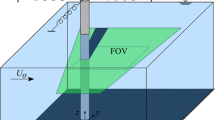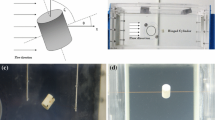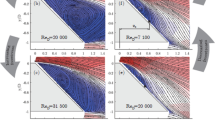Abstract
The wake development of a pivoted circular cylinder undergoing vortex-induced vibrations with elliptical trajectories is examined experimentally at a fixed Reynolds number of 3027 and mass ratio of 10.8. Simultaneous cylinder displacement measurements and time-resolved, two-component particle image velocimetry in multiple horizontal and vertical planes are used to quantify the structural response and wake development. The selected test cases pertain to \(U^*=U_0/f_\mathrm{n} D=5.48\) and 7.08, and exhibit different orientations of elliptical cylinder trajectory, both with a clockwise direction of orbiting. Three-dimensional reconstructions of the phase-averaged wake velocity measurements reveal 2S shedding along the span of a stationary cylinder and hybrid shedding for the two vibrating cylinder cases, with planar wake topology transitioning from 2S to P+S to 2S for \(U^*=5.48\), and 2S to P+S for 7.08. The observed wake topologies show significant deviation from predictions based on the Morse and Williamson (J Fluids Struct 25(4):697–712, 2009) shedding map. Vortex identification and strength quantification are used to provide insight into vortex dynamics and to propose a model of the dislocations. Examination of the time averaged wake characteristics shows the formation length, wake half-width, and maximum velocity deficit exhibit distinct spanwise trends aligning with the regions associated with specific shedding regimes.















Similar content being viewed by others
Abbreviations
- AR:
-
Aspect ratio, L / D
- \(A_x, A_y\) :
-
Half of peak-to-peak amplitude of streamwise and transverse vibrations, respectively
- \(A_x^*, A_y^*\) :
-
Normalized amplitude of streamwise and transverse vibrations, \(A_x/D,~A_y/D\), respectively
- \(a_{i}\) :
-
Temporal POD coefficients
- D :
-
Cylinder diameter
- \(d_{\mathrm{wake}}\) :
-
Wake half-width
- \(f_\mathrm{n}\) :
-
Natural frequency in quiescent water
- \(f_\mathrm{s}\) :
-
Vortex shedding frequency of a stationary cylinder
- \(f_u,f_v\) :
-
Frequency of the streamwise and transverse velocity signal, respectively
- \(f_x, f_y\) :
-
Frequency of streamwise and transverse vibrations, respectively
- I :
-
Moment of inertia of the cylinder about the pivot point
- \(I_\mathrm{d}\) :
-
Moment of inertia of the displaced fluid about the pivot point
- \(I^*\) :
-
Moment of inertia ratio, \(I/I_\mathrm{d}\)
- \(\hat{i}, \hat{j}, \hat{k}\) :
-
Unit vectors in x, y, z directions, respectively
- k :
-
Spring stiffness coefficient
- L :
-
Length of cylinder
- \(L_\mathrm{f}\) :
-
Formation length
- m :
-
Mass of the cylinder
- \(m_\mathrm{d}\) :
-
Mass of displaced fluid
- \(m^*\) :
-
Mass ratio, \(m/m_\mathrm{d}\)
- PSD:
-
Power spectrum density
- Re :
-
Reynolds number, \(Re = U_0D/\nu\)
- \(\mathbf {U}\) :
-
Mean velocity field, \(\mathbf {U}=U\hat{i}+V\hat{j}+W\hat{k}\)
- \(U_0\) :
-
Free stream velocity
- \(U_\mathrm{d}\) :
-
Local velocity deficit
- \(U_\mathrm{e}\) :
-
Velocity at the transverse extent of the wake measurements
- \(U^*\) :
-
Reduced velocity, \(U_0/f_\mathrm{n}D\)
- \(\mathbf {u}\) :
-
Velocity field, \(\mathbf {u}=u\hat{i}+v\hat{j}+w\hat{k}\)
- \(\mathbf {u}_{\mathrm{RMS}}\) :
-
Root-mean-square (RMS) velocity field, \(\mathbf {u}_{\mathrm{RMS}}=u_{\mathrm{RMS}}\hat{i}+v_{\mathrm{RMS}}\hat{j}+w_{\mathrm{RMS}}\hat{k}\)
- x, y, z :
-
Streamwise, transverse and spanwise directions, respectively
- \(\varGamma\) :
-
Circulation
- \(\varDelta \theta\) :
-
Phase bin size
- \(\zeta\) :
-
Damping ratio
- \(\theta\) :
-
Phase angle of the cylinder’s elliptic orbit
- \(\lambda _{i}\) :
-
POD mode energy
- \(\nu\) :
-
Kinematic viscosity of water
- \(\mathbf {\phi _i}\) :
-
Spatial POD modes, \(\mathbf {\phi _i} = \phi _{ix}\hat{i} + \phi _{iy}\hat{j}\)
- \(\psi\) :
-
Phase angle between streamwise and transverse motion
- \(\omega _z\) :
-
Spanwise vorticity
References
Bearman PW (1965) Investigation of the flow behind a two-dimensional model with a blunt trailing edge and fitted with splitter plates. J Fluid Mech 21(02):241
Bearman PW (1967) On vortex street wakes. J Fluid Mech 28(04):625–641
Bearman PW (1984) Vortex shedding from oscillating bluff bodies. Annu Rev Fluid Mech 16(1):195–222
Bernitsas MM, Raghavan K, Ben-Simon Y, Garcia EMH (2008) VIVACE (vortex induced vibration aquatic clean energy): a new concept in generation of clean and renewable energy from fluid flow. J Offshore Mech Arct Eng 130(4):041101
Blevins RD, Coughran CS (2009) Experimental investigation of vortex-induced vibration in one and two dimensions with variable mass, damping, and Reynolds number. J Fluids Eng 131(10):101202
Cagney N, Balabani S (2014) Streamwise vortex-induced vibrations of cylinders with one and two degrees of freedom. J Fluid Mech 758:702–727
Chong MS, Perry AE, Cantwell BJ (1990) A general classification of three dimensional flow fields. Phys Fluids A Fluid Dyn 2(5):765–777
Dailey JE, Weidler JB, Hanna SY, Zedan MF, Yeung JY (1987) Pile fatigue failures. 3: motions in seas. J Waterw Port Coast Ocean Eng 113(3):233–250
Every M, King R, Weaver D (1982) Vortex-excited vibrations of cylinders and cables and their suppression. Ocean Eng 9(2):135–157
Feng CC (1968) The measurement of vortex induced effects in flow past stationary and oscillating circular and D-section cylinders. Masters in applied science thesis, University of British Columbia
Ferré JA, Giralt F (1989) Pattern-recognition analysis of the velocity field in plane turbulent wakes. J Fluid Mech 198:27
Flemming F, Williamson C (2005) Vortex-induced vibrations of a pivoted cylinder. J Fluid Mech 522:215–252
Gao Y, Fu S, Xiong Y, Zhao Y, Liu L (2016) Experimental study on response performance of vortex-induced vibration on a flexible cylinder. Ships Offshore Struct 12(1):116–134
Gerrard JH (1966) The mechanics of the formation region of vortices behind bluff bodies. J Fluid Mech 25:401–413
Gharib MR (1999) Vortex-induced vibration, absence of lock-in and fluid force deduction. Phd, California Institute of Technology
Govardhan R, Williamson CHK (2000) Modes of vortex formation and frequency response of a freely vibrating cylinder. J Fluid Mech 420:85–130
Graftieaux L, Michard M, Grosjean N (2001) Combining PIV, POD and vortex identification algorithms for the study of unsteady turbulent swirling flows. Meas Sci Technol 12(9):1422–1429
Griffin OM (1995) A note on bluff body vortex formation. J Fluid Mech 284:217–224
Huera-Huarte F, Bearman P (2009) Wake structures and vortex-induced vibrations of a long flexible cylinder-part 1: dynamic response. J Fluids Struct 25(6):969–990
Hunt JC, Wray AA, Moin P (1988) Eddies, streams, and convergence zones in turbulent flows. In: Proceedings of the Summer Program, Center for Turbulence Research, pp 193–208
Huse E, Kleiven G, Nielsen F (1998) Large scale model testing of deep sea risers. In: offshore technology conference, offshore technology conference, pp 1–9
Jauvtis N, Williamson CHK (2004) The effect of two degrees of freedom on vortex-induced vibration at low mass and damping. J Fluid Mech 509:23–62
Jeon D, Gharib M (2001) On circular cylinders undergoing two-degree-of-freedom forced motions. J Fluids Struct 15(3–4):533–541
Jeong J, Hussain F (1995) On the identification of a vortex. J Fluid Mech 285:69–94
Khalak A, Williamson C (1997) Fluid forces and dynamics of a hydroelastic structure with very low mass and damping. J Fluids Struct 11(8):973–982
Khalak A, Williamson C (1999) Motions, forces and mode transitions in vortex-induced vibrations at low mass-damping. J Fluids Struct 13(7–8):813–851
Kheirkhah S, Yarusevych S, Narasimhan S (2012) Orbiting response in vortex-induced vibrations of a two-degree-of-freedom pivoted circular cylinder. J Fluids Struct 28:343–358
Kheirkhah S, Yarusevych S, Narasimhan S (2016) Wake topology of a cylinder undergoing vortex-induced vibrations with elliptic trajectories. J Fluids Eng 138(5):054501
Kim J, Moin P, Moser R (1987) Turbulence statistics in fully developed channel flow at low Reynolds number. J Fluid Mech 177:133–166
King R (1974) Vortex excited structural oscillations of a circular cylinder in flowing water. Phd, Loughborough University
Leong C, Wei T (2008) Two-degree-of-freedom vortex-induced vibration of a pivoted cylinder below critical mass ratio. Proc R Soc A Math Phys Eng Sci 464(2099):2907–2927
Marble E, Morton C, Yarusevych S (2018) Vortex dynamics in the wake of a pivoted cylinder undergoing vortex-induced vibrations with elliptic trajectories. Exp Fluids 59(5):16
Moe G, Wu Z (1990) The lift force on a cylinder vibrating in a current. J Offshore Mech Arct Eng 112(4):297
Moin P, Kim J (1985) The structure of the vorticity field in turbulent channel flow. Part 1. Analysis of instantaneous fields and statistical correlations. J luid Mech 155:441–464
Morse T, Williamson C (2009) Fluid forcing, wake modes, and transitions for a cylinder undergoing controlled oscillations. J Fluids Struct 25(4):697–712
Morton BR (1984) The generation and decay of vorticity. Geophys Astrophys Fluid Dyn 28(3–4):277–308
Norberg C (2001) Flow around a circular cylinder: aspects of fluctuating lift. J Fluids Struct 15(3–4):459–469
Oviedo-Tolentino F, Pérez-Gutiérrez F, Romero-Méndez R, Hernández-Guerrero A (2014) Vortex-induced vibration of a bottom fixed flexible circular beam. Ocean Eng 88:463–471
Perrin R, Braza M, Cid E, Cazin S, Barthet A, Sevrain A, Mockett C, Thiele F (2007) Obtaining phase averaged turbulence properties in the near wake of a circular cylinder at high Reynolds number using POD. Exp Fluids 43(2–3):341–355
Roshko A (1955) On the wake and drag of bluff bodies. J Aeronaut Sci 22(2):124–132
Roshko A (1993) Perspectives on bluff body aerodynamics. J Wind Eng Ind Aerodyn 49(1–3):79–100
Sanchis A, Sælevik G, Grue J (2008) Two-degree-of-freedom vortex-induced vibrations of a spring-mounted rigid cylinder with low mass ratio. J Fluids Struct 24(6):907–919
Sarpkaya T (1995) Hydrodynamic damping, flow-induced oscillations, and biharmonic response. J Offshore Mech Arct Eng 117(4):232
Sarpkaya T (2004) A critical review of the intrinsic nature of vortex-induced vibrations. J Fluids Struct 19(4):389–447
Schaefer JW, Eskinazi S (1959) An analysis of the vortex street generated in a viscous fluid. J Fluid Mech 6(02):241
Song Jn LuL, Teng B, Hi Park, Tang Gq WuH (2011) Laboratory tests of vortex-induced vibrations of a long flexible riser pipe subjected to uniform flow. Ocean Eng 38(11–12):1308–1322
Stephen N (2006) On energy harvesting from ambient vibration. J Sound Vib 293(1–2):409–425
Techet AH, Hover FS, Triantafyllou MS (1998) Vortical patterns behind a tapered cylinder oscillating transversely to a uniform flow. J Fluid Mech 363:79–96
van Oudheusden BW, Scarano F, van Hinsberg NP, Watt DW (2005) Phase-resolved characterization of vortex shedding in the near wake of a square-section cylinder at incidence. Exp Fluids 39(1):86–98
Vandiver JK, Jaiswal V, Jhingran V (2009) Insights on vortex-induced, traveling waves on long risers. J Fluids Struct 25(4):641–653
Vickery B, Watkins R (1964) Flow-induced vibrations of cylindrical structures. In: Hydraulics and fluid mechanics. Proceedings of the First Australasian Conference Held at the University of Western Australia, 6th to 13th December 1962. Elsevier, Pergamon, pp 213–241. https://doi.org/10.1016/B978-0-08-010291-7.50018-5
Welch P (1967) The use of fast Fourier transform for the estimation of power spectra: a method based on time averaging over short, modified periodograms. IEEE Trans Audio Electroacoust 15(2):70–73
Wieneke B (2015) PIV uncertainty quantification from correlation statistics. Meas Sci Technol 26(7):074002
Williamson CHK (1996) Vortex dynamics in the cylinder wake. Annu Rev Fluid Mech 28(1):477–539
Williamson C, Govardhan R (2004) Vortex-induced vibrations. Annu Rev Fluid Mech 36(1):413–455
Williamson C, Roshko A (1988) Vortex formation in the wake of an oscillating cylinder. J Fluids Struct 2(4):355–381
Zdravkovich M (1981) Review and classification of various aerodynamic and hydrodynamic means for suppressing vortex shedding. J Wind Eng Ind Aerodyn 7(2):145–189
Zhou J, Adrian RJ, Balachandar S, Kendall TM (1999) Mechanisms for generating coherent packets of hairpin vortices in channel flow. J Fluid Mech 387:353–396
Acknowledgements
The authors gratefully acknowledge the Natural Sciences and Engineering Research Council of Canada (NSERC) (RGPIN-2017-04222) for funding this work.
Author information
Authors and Affiliations
Corresponding author
Additional information
Publisher's Note
Springer Nature remains neutral with regard to jurisdictional claims in published maps and institutional affiliations.
Rights and permissions
About this article
Cite this article
Marble, E., Morton, C. & Yarusevych, S. Spanwise wake development of a pivoted cylinder undergoing vortex-induced vibrations with elliptic trajectories. Exp Fluids 60, 81 (2019). https://doi.org/10.1007/s00348-019-2725-2
Received:
Revised:
Accepted:
Published:
DOI: https://doi.org/10.1007/s00348-019-2725-2




